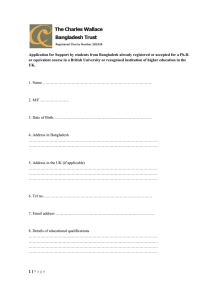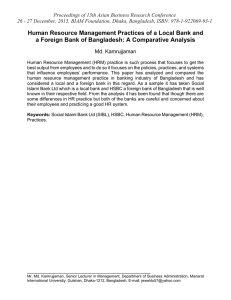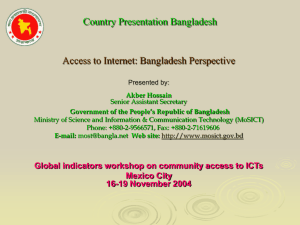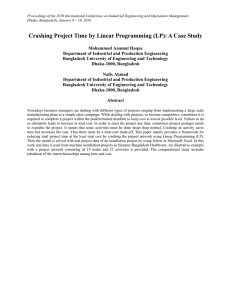radio frequency technology in telecommunication system
advertisement
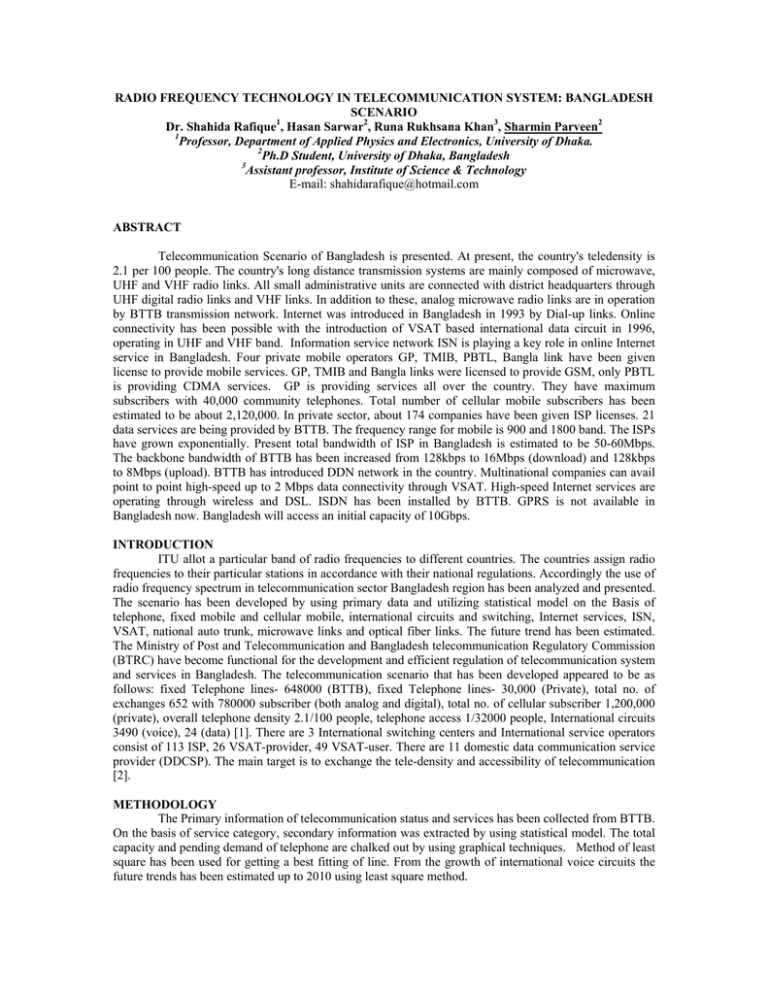
RADIO FREQUENCY TECHNOLOGY IN TELECOMMUNICATION SYSTEM: BANGLADESH SCENARIO Dr. Shahida Rafique1, Hasan Sarwar2, Runa Rukhsana Khan3, Sharmin Parveen2 1 Professor, Department of Applied Physics and Electronics, University of Dhaka. 2 Ph.D Student, University of Dhaka, Bangladesh 3 Assistant professor, Institute of Science & Technology E-mail: shahidarafique@hotmail.com ABSTRACT Telecommunication Scenario of Bangladesh is presented. At present, the country's teledensity is 2.1 per 100 people. The country's long distance transmission systems are mainly composed of microwave, UHF and VHF radio links. All small administrative units are connected with district headquarters through UHF digital radio links and VHF links. In addition to these, analog microwave radio links are in operation by BTTB transmission network. Internet was introduced in Bangladesh in 1993 by Dial-up links. Online connectivity has been possible with the introduction of VSAT based international data circuit in 1996, operating in UHF and VHF band. Information service network ISN is playing a key role in online Internet service in Bangladesh. Four private mobile operators GP, TMIB, PBTL, Bangla link have been given license to provide mobile services. GP, TMIB and Bangla links were licensed to provide GSM, only PBTL is providing CDMA services. GP is providing services all over the country. They have maximum subscribers with 40,000 community telephones. Total number of cellular mobile subscribers has been estimated to be about 2,120,000. In private sector, about 174 companies have been given ISP licenses. 21 data services are being provided by BTTB. The frequency range for mobile is 900 and 1800 band. The ISPs have grown exponentially. Present total bandwidth of ISP in Bangladesh is estimated to be 50-60Mbps. The backbone bandwidth of BTTB has been increased from 128kbps to 16Mbps (download) and 128kbps to 8Mbps (upload). BTTB has introduced DDN network in the country. Multinational companies can avail point to point high-speed up to 2 Mbps data connectivity through VSAT. High-speed Internet services are operating through wireless and DSL. ISDN has been installed by BTTB. GPRS is not available in Bangladesh now. Bangladesh will access an initial capacity of 10Gbps. INTRODUCTION ITU allot a particular band of radio frequencies to different countries. The countries assign radio frequencies to their particular stations in accordance with their national regulations. Accordingly the use of radio frequency spectrum in telecommunication sector Bangladesh region has been analyzed and presented. The scenario has been developed by using primary data and utilizing statistical model on the Basis of telephone, fixed mobile and cellular mobile, international circuits and switching, Internet services, ISN, VSAT, national auto trunk, microwave links and optical fiber links. The future trend has been estimated. The Ministry of Post and Telecommunication and Bangladesh telecommunication Regulatory Commission (BTRC) have become functional for the development and efficient regulation of telecommunication system and services in Bangladesh. The telecommunication scenario that has been developed appeared to be as follows: fixed Telephone lines- 648000 (BTTB), fixed Telephone lines- 30,000 (Private), total no. of exchanges 652 with 780000 subscriber (both analog and digital), total no. of cellular subscriber 1,200,000 (private), overall telephone density 2.1/100 people, telephone access 1/32000 people, International circuits 3490 (voice), 24 (data) [1]. There are 3 International switching centers and International service operators consist of 113 ISP, 26 VSAT-provider, 49 VSAT-user. There are 11 domestic data communication service provider (DDCSP). The main target is to exchange the tele-density and accessibility of telecommunication [2]. METHODOLOGY The Primary information of telecommunication status and services has been collected from BTTB. On the basis of service category, secondary information was extracted by using statistical model. The total capacity and pending demand of telephone are chalked out by using graphical techniques. Method of least square has been used for getting a best fitting of line. From the growth of international voice circuits the future trends has been estimated up to 2010 using least square method. Trend line Dhaka Chittagong Khulna Rajshahi Conn. Pending V Cir(y) calY 19 97 19 98 19 99 20 00 20 01 20 02 Capacity 3500 3000 2500 2000 1500 1000 500 0 Fig. 1 Fig. 2 Yearwise Trend 1200 1000 800 600 400 200 0 No of PC Internet users CellPhone Subs Fixed Phone 16 14 12 10 8 6 4 2 0 Upload bandwidth Download bandwidth 1999 2000 2001 2002 2003 2004 1998 1999 2000 2001 2002 Fig. 3 Fig. 4 20022003 20002001 Connectoin Year Fig. 5 Telephone growth Pending demand Telephone Exchance Status 1000000 500000 0 Capcity Dhaka Capcity Telephone Status 1000000 800000 600000 400000 200000 0 19981999 Telephone growth Telephone growth khulna 450000 400000 350000 300000 250000 200000 150000 100000 50000 0 Region Connectoin Pending demand Fig. 6 Telephone Exchange Status RESULT Telephone exchange status (capacity, connection and pending demand) is shown in line diagram in Fig.1. The least square line estimated from Table-1 using the equations (1),(2),(3). The calculated least square line Y = 2155+331.143 X. This equation obtains applying the future trend value for 2020 is estimated. This value is 5476.43. Trend line shown in the Fig. 2. Year-wise telephone growth is shown in Fig. 3. Correlation of coefficients has been found using the equation (5), whose value is r = -0.027. Internet growth in Bangladesh from 1993-2002 can be observed from line diagram shown in Fig. 4. .bd registration may be realized from the year-wise number of registration. The year wise telephone growth is shown in the Fig. 5. It is clear that the no. of exchange has increased from 631 (’98-‘99) to 652 (2002-03) with an exchange capacity from 474322 to 928993 (total). The telephone connection has increased accordingly from 432,968 to 716,721. However, there still remains pending demand which was 172 in the year ‘98-’99 to 201852 (2002- 03). It has also been found that although the demand is increasing, capacity is there. The region wise current telephone exchange status is shown in Fig. 6. It has been realized that BTTB is providing telephone services all over the country and almost all the exchange are converted to digital by 2004. Year wise bandwidth growth [3] is shown in Fig.8. It has been found that BTTB has increased its total backbone bandwidth starting from 256 Kbps in 1999 to 24.0 Mbps in 2004 according to demand. DIGITAL MICROWAVE RADIO LINK The long distance transmission systems in Bangladesh are mainly composed of microwave, VHF and UHF radio links. Major microwave links are shown in Fig.3. The first digital backbone microwave link was commissioned in 1991. It is 140Mbps PDH link of 2+1 configuration. Two more digital backbone microwave links were installed in 1993-94. Another two PDH microwave backbone link of 34 Mbps capacity have been installed in 1994. Apart from this, there are a number of 34 Mbps and 8 Mbps spur link are working in various districts. Point to point STM-1 links have been installed during the year 2001. All Upazilla Headquarters (the smallest administrative unit) are connected with their respective district headquarters through UHF links most of which are now digital radio systems. Also some of the district headquarters are interconnected through digital UHF links. In addition to those some analog microwave radio link are in operation by BTTB transmission network. Transmission network on rural area is digital except some hilly districts. INTERNET GROWTH Bangladesh entered the Internet world in 1993 using offline E-mail services. Online Dial-up services started in 1996 through VSAT based data connectivity. Information Service Network (ISN) is playing a vital role in introducing online Internet service in Bangladesh. Number of Dial-up service account holders of BTTB net increased by more than three-fold during the last three years. The year 2002 experienced highest growth due to reduction of Internet registration fee and usage charge. Internet service is available to phone users of 64 districts and 164 Upazillas having digital exchange. By April, 2004 Internet is being used from 60 Upazillas. To cater the demand, BTTB had to increase its backbone bandwidth accordingly. Starting with a 128 Kbps duplex connection, BTTB’s total upload and download bandwidth reached to 10Mbps now. The total BW of all ISP has been estimated to be 50-60 Mbps. 15000 30000 25000 20000 15000 10000 5000 0 Year Bandwidth Year 10000 No of dial up sub 5000 0 1 2 3 4 5 6 Fig. 8 Bandwidth Growth 1 2 3 4 5 6 Fig. 9 Growth of Dial up subscriber The bandwidth growth of BTTB net and growth of BTTB post paid Internet subscriber is shown in fig 4 and 5 respectively. BTTB has been registering domain names under country code .bd. There are several sub-domain like .com, .net, .org, .edu, .ac, .gov, .mil, etc. BTTB maintains separate primary and secondary domain name server for .bd service. Up to November 2003, total 295 domain names have been found to be registered, of which 23 domain names have been found to be registered by educational identity. High speed Internet service has been provided by privet ISPs through wireless and DSL. In private sector about 174 companies are providing ISPs. Total subscriber of ISPs are about 80,000. There are 31 VSAT provider and 70 VSAT user. ISDN has also been installed by BTTB, but the service has not been introduced. General packet radio service (GPRS) is not available in Bangladesh. BTTB broadband Internet service has been extended to 23 places at 13 district head quarter for corporate organizations, banks, universities, and colleges, multinational companies in Bangladesh. Internet access up to 2Mbps is being provided by telephone cable through DDN (Digital Data Network). The service is over VSAT based. There are some redundant link. BTTB maintains 3 backbone links- one 2 Mbps full duplex and another 2 Mbps simplex, connected with UK through carrier and wireless and third one is connected to Canada through Telegroup. BTTB replaced all analog access ports with E1 connectivity. This is believed to be faster that the access through analog port. MOBILE SERVICE Four private mobile operators Grameen Phone, TM International Bangladesh (TMIB), Pacific Bangladesh Telecom limited (PBTL), Banglalink (Seba telecom) are providing mobile services. PBTL uses AMPS and CDMA services, other 3 GP, TMIB, Seba GSM services. They are using 900 MHz to 1800 MHz frequency band. GP has maximum subscriber serving 40,000 community telephone. Total no. of cellular mobile subscriber at present 2,128,000. BTTB has recently started to provide cellular service using GSM system. They all are using microwave radio frequency band. There exists data service provider in private sectors giving data services within the country. SATTELITE COMUNICATION Advanced digital transmission technologies and radio frequency are in operation in Bangladesh for satellite transmission to facilitate tranceiption through satellite. BTTB has established 4 earth stations till to date. They are situated in Betbunia (standard A), Talibabad (standard B), Mohakhali (Standard A), Sylhet (Standard F3). They all are working with INTELSAT at 60º E IOR and their carrier is IDR. 462 International Circuits (voice 457,VFT 2, data 3) with 8 countries are working through Betbunia earth station. 331 International Circuits (voice 328, VFT 3, ) with 2 countries are working through Talibabad earth station. 2741 (voice, VFT 5, data 11) International Circuits with 20countries are working through Mahakhali earth station. 128 International Circuits are working through Sylhet earth station. In addition to that 100 terrestrial International Circuits between 2 countries are working via microwave. These earth stations are operating with different INTELSAT. Till to date BTTB has five INMARSAT-A Terminals which are operating through one LES (Land Earth Station) located in Jeddah. Besides this according to IMN number allocated by BTTB, there are two numbers B type (Land Mobile), 34 numbers C type (Maritime Mobile) and 5 numbers Mini-M type Terminal working in commercial basis. DISCUSSION Bangladesh has a firm policy to digitalize a nationwide high-speed network. Satellite and VSAT technology are there, but these seem to be inferior in today's communication technology. Bangladesh has joined the SEA-ME-WE Consortium cable route. Bangladesh has landing station in Cox's Bazar. This submarine cable will provide broadband connectivity to the global information super highway with overseas gateway facilities for high-speed data transfer. This will hopefully contribute a sizeable amount of revenue to the Government of Bangladesh from its earnings. CONCLUSION Telecommunication scenario of Bangladesh is presented. The observed pending demand has been found to be increasing exponentially as compared with the telecommunication expansion. Optical network seems to be expensive initially but this is reliable and high-speed system as compared with the radio link. The growth of Internet has been found to be non-linear in nature - which is inconsistent with the growth of PC. The growth of domain name .bd registration has been found to be exponential during the 2001-2003. Dial-up system is more popular for connecting the home and offices in Bangladesh. High-speed Internet services are provided by some ISPs. Bangladesh has installed ISDN lines in some exchanges but ADSL service has not been introduced. GPRS service is not available in Bangladesh. Data circuits using satellite or VSAT technology has time delay of 500 millisecond. However, this will be avoided by submarine cable network. Growth of backbone bandwidth has been found to be increasing very fast. However, Internet service is available in 64 districts. It may be concluded that there has been a considerable amount of advancement in developing telecommunication infrastructure in Bangladesh. REFERENCES [1] BTTB Annual Report 2002-2003. [2] Bangladesh APT yearbook 2004. [3] A.K.M.H. Rahman, “Data and Internet Service: BTTB Scenario”.
